1998 OPEL FRONTERA ignition
[x] Cancel search: ignitionPage 5502 of 6000

6E–73 4JX1–TC ENGINE DRIVEABILITY AND EMISSIONS
DTC P0122 –AP Sensor Low Voltage
StepNo Ye s Va l u e ( s ) Action
31. Ignition “ON,” engine “OFF.”
2. With the throttle closed, observe the “AP Sensor”
display on the Tech 2.
Is the “AP Sensor” below the specified value?
0.1 VGo to Step 5Go to Step 4
41. Ignition “ON,” engine “OFF.”
2. Review and record Tech 2 Failure Records data.
3. Operate the vehicle within Failure Records
conditions as noted.
4. Using a Tech 2, monitor the “DTC” info for DTC
P0122.
Does the Tech 2 indicate DTC P0122 failed?
—Go to Step 5
Refer to
Diagnostic
Aids
51. Ignition “OFF.”
2. Disconnect the AP sensor electrical connector.
3. Jumper the 5 volt reference “J2” circuit and the AP
signal together at the AP sensor harness connector.
4. Ignition “ON.”
Observe the “AP Sensor” display on the Tech 2.
Is the “AP Sensor” at the specified value?
5 VGo to Step 11Go to Step 6
61. Disconnect jumper.
2. Connect a test light between B+ and the AP sensor
signal circuit at the AP sensor harness connector.
Observe the “AP Sensor” display on the Tech 2.
Is the “AP Sensor” at the specified value?
5 VGo to Step 7Go to Step 9
71. Ignition “OFF.”
2. Disconnect the ECM and check the 5 volt reference
“A” circuit for an open or short to ground.
3. If the 5 volt reference “J2” circuit is open or shorted
to ground, repair it as necessary.
Was the 5 volt reference “J2” circuit open or shorted to
ground?
—Verify repairGo to Step 8
8Check the 5 volt reference “J2” circuit for a poor
connection at the ECM and replace the terminal if
necessary.
Did the terminal require replacement?
—Verify repairGo to Step 13
91. Ignition “OFF.”
2. Disconnect the ECM, and check the AP signal
circuit for an open, short to ground, or short to the
sensor ground circuit.
3. If the AP sensor signal circuit is open or shorted to
ground, repair it as necessary.
Was the AP signal circuit open or shorted to ground?
—Verify repairGo to Step 10
10Check the AP sensor signal circuit for a poor
connection at the ECM and replace the terminal if
necessary.
Did the terminal require replacement?
—Verify repairGo to Step 13
11Check the AP sensor signal circuit for a poor
connection at the AP sensor and replace the terminal if
necessary.
Did the terminal require replacement?
—Verify repairGo to Step 12
Page 5504 of 6000
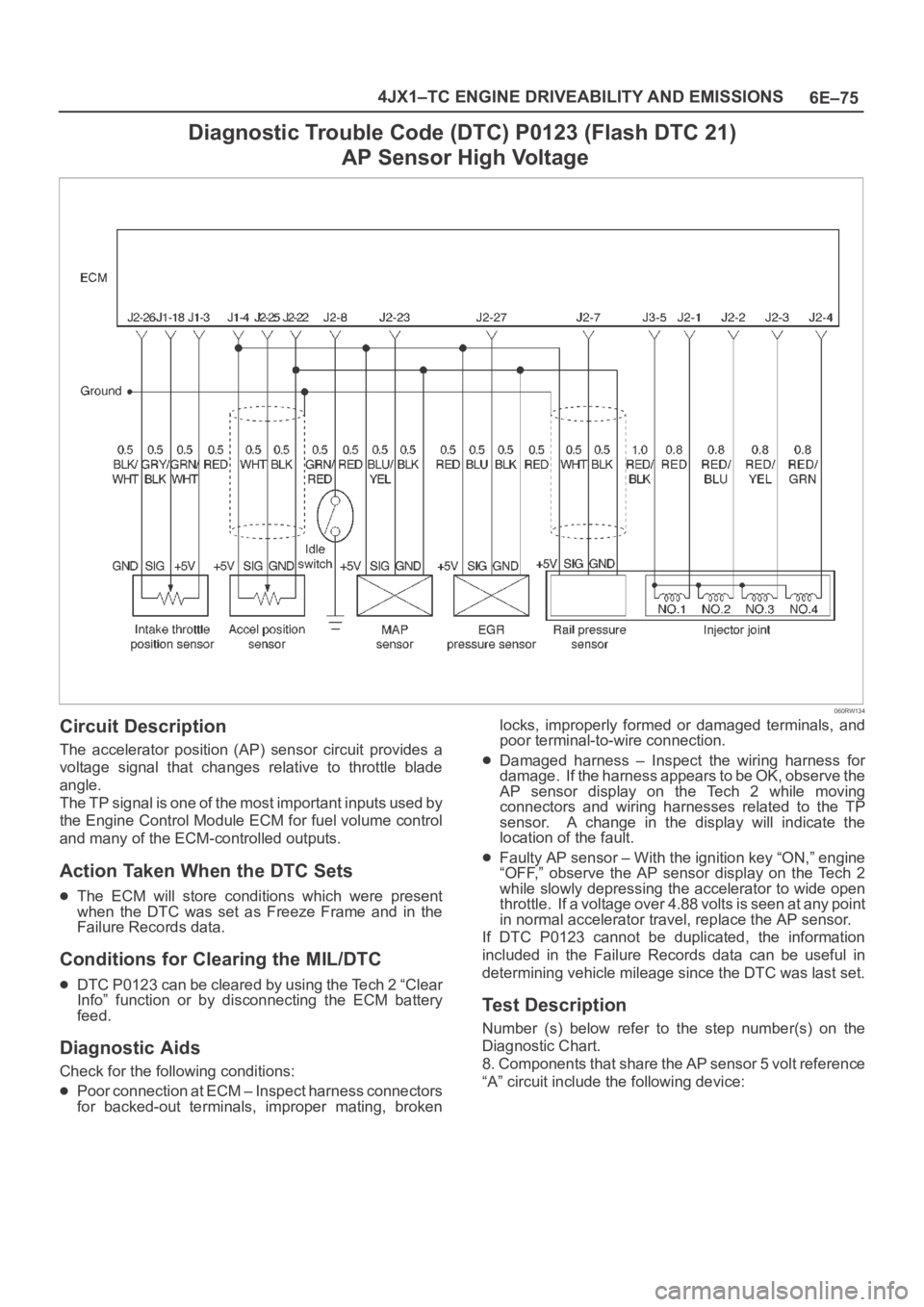
6E–75 4JX1–TC ENGINE DRIVEABILITY AND EMISSIONS
Diagnostic Trouble Code (DTC) P0123 (Flash DTC 21)
AP Sensor High Voltage
060RW134
Circuit Description
The accelerator position (AP) sensor circuit provides a
voltage signal that changes relative to throttle blade
angle.
The TP signal is one of the most important inputs used by
the Engine Control Module ECM for fuel volume control
and many of the ECM-controlled outputs.
Action Taken When the DTC Sets
The ECM will store conditions which were present
when the DTC was set as Freeze Frame and in the
Failure Records data.
Conditions for Clearing the MIL/DTC
DTC P0123 can be cleared by using the Tech 2 “Clear
Info” function or by disconnecting the ECM battery
feed.
Diagnostic Aids
Check for the following conditions:
Poor connection at ECM – Inspect harness connectors
for backed-out terminals, improper mating, brokenlocks, improperly formed or damaged terminals, and
poor terminal-to-wire connection.
Damaged harness – Inspect the wiring harness for
damage. If the harness appears to be OK, observe the
AP sensor display on the Tech 2 while moving
connectors and wiring harnesses related to the TP
sensor. A change in the display will indicate the
location of the fault.
Faulty AP sensor – With the ignition key “ON,” engine
“OFF,” observe the AP sensor display on the Tech 2
while slowly depressing the accelerator to wide open
throttle. If a voltage over 4.88 volts is seen at any point
in normal accelerator travel, replace the AP sensor.
If DTC P0123 cannot be duplicated, the information
included in the Failure Records data can be useful in
determining vehicle mileage since the DTC was last set.
Test Description
Number (s) below refer to the step number(s) on the
Diagnostic Chart.
8. Components that share the AP sensor 5 volt reference
“A” circuit include the following device:
Page 5505 of 6000
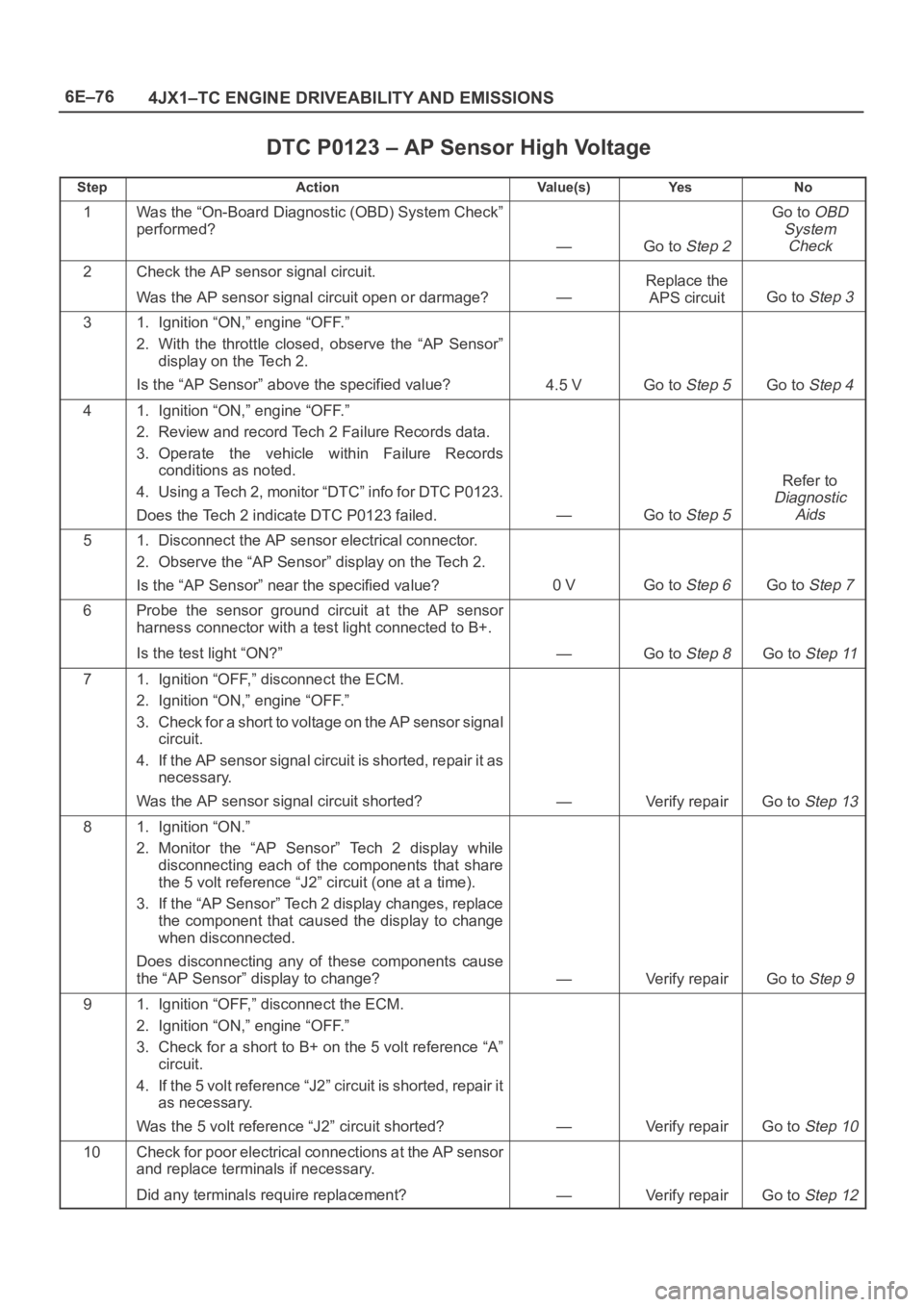
6E–76
4JX1–TC ENGINE DRIVEABILITY AND EMISSIONS
DTC P0123 – AP Sensor High Voltage
StepActionVa l u e ( s )Ye sNo
1Was the “On-Board Diagnostic (OBD) System Check”
performed?
—Go to Step 2
Go to OBD
System
Check
2Check the AP sensor signal circuit.
Was the AP sensor signal circuit open or darmage?
—
Replace the
APS circuit
Go to Step 3
31. Ignition “ON,” engine “OFF.”
2. With the throttle closed, observe the “AP Sensor”
display on the Tech 2.
Is the “AP Sensor” above the specified value?
4.5 VGo to Step 5Go to Step 4
41. Ignition “ON,” engine “OFF.”
2. Review and record Tech 2 Failure Records data.
3. Operate the vehicle within Failure Records
conditions as noted.
4. Using a Tech 2, monitor “DTC” info for DTC P0123.
Does the Tech 2 indicate DTC P0123 failed.
—Go to Step 5
Refer to
Diagnostic
Aids
51. Disconnect the AP sensor electrical connector.
2. Observe the “AP Sensor” display on the Tech 2.
Is the “AP Sensor” near the specified value?
0 VGo to Step 6Go to Step 7
6Probe the sensor ground circuit at the AP sensor
harness connector with a test light connected to B+.
Is the test light “ON?”
—Go to Step 8Go to Step 11
71. Ignition “OFF,” disconnect the ECM.
2. Ignition “ON,” engine “OFF.”
3. Check for a short to voltage on the AP sensor signal
circuit.
4. If the AP sensor signal circuit is shorted, repair it as
necessary.
Was the AP sensor signal circuit shorted?
—Verify repairGo to Step 13
81. Ignition “ON.”
2. Monitor the “AP Sensor” Tech 2 display while
disconnecting each of the components that share
the 5 volt reference “J2” circuit (one at a time).
3. If the “AP Sensor” Tech 2 display changes, replace
the component that caused the display to change
when disconnected.
Does disconnecting any of these components cause
the “AP Sensor” display to change?
—Verify repairGo to Step 9
91. Ignition “OFF,” disconnect the ECM.
2. Ignition “ON,” engine “OFF.”
3. Check for a short to B+ on the 5 volt reference “A”
circuit.
4. If the 5 volt reference “J2” circuit is shorted, repair it
as necessary.
Was the 5 volt reference “J2” circuit shorted?
—Verify repairGo to Step 10
10Check for poor electrical connections at the AP sensor
and replace terminals if necessary.
Did any terminals require replacement?
—Verify repairGo to Step 12
Page 5506 of 6000
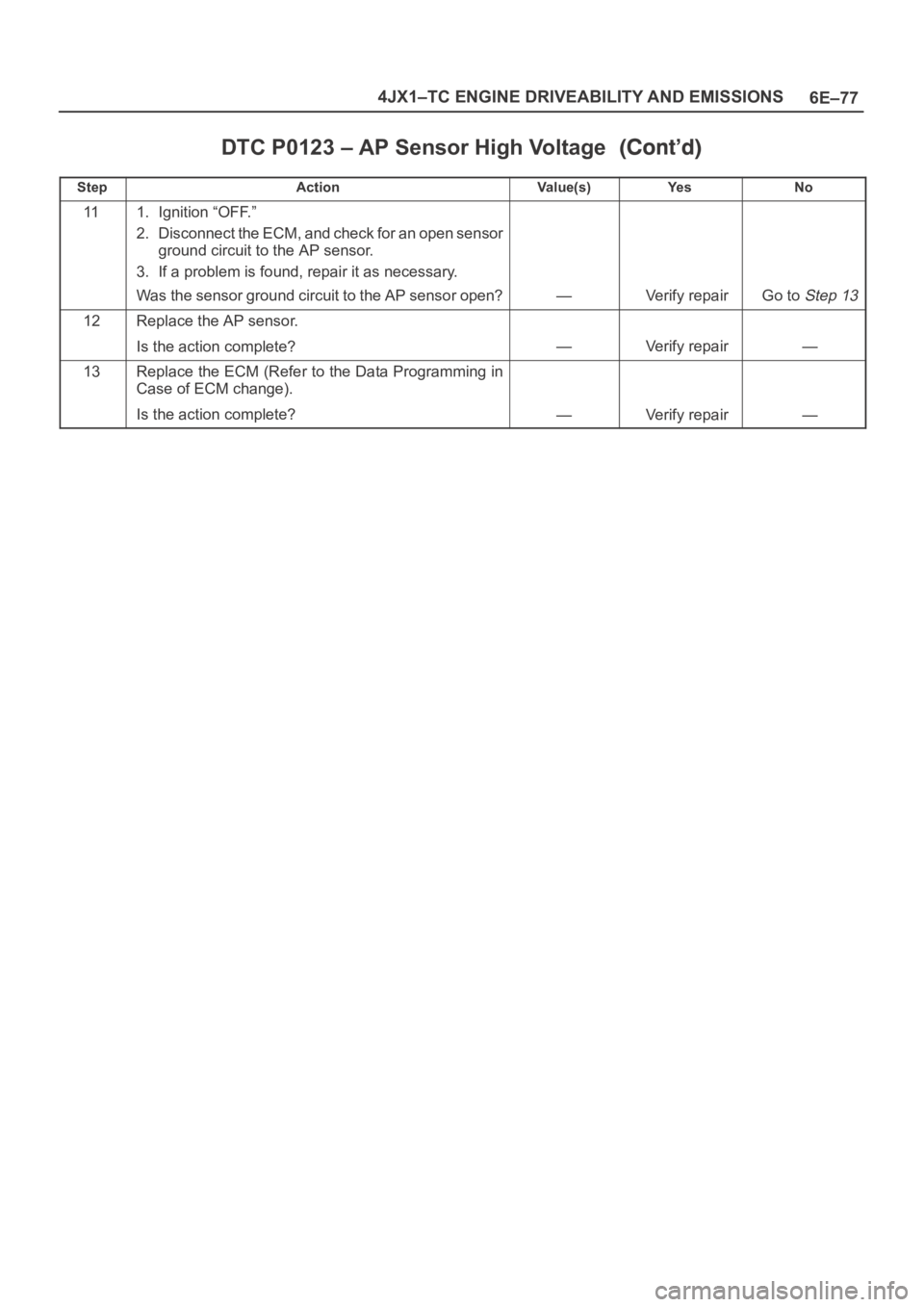
6E–77 4JX1–TC ENGINE DRIVEABILITY AND EMISSIONS
DTC P0123 – AP Sensor High Voltage
StepNo Ye s Va l u e ( s ) Action
111. Ignition “OFF.”
2. Disconnect the ECM, and check for an open sensor
ground circuit to the AP sensor.
3. If a problem is found, repair it as necessary.
Was the sensor ground circuit to the AP sensor open?
—Verify repairGo to Step 13
12Replace the AP sensor.
Is the action complete?
—Verify repair—
13Replace the ECM (Refer to the Data Programming in
Case of ECM change).
Is the action complete?
—Verify repair—
Page 5508 of 6000

6E–79 4JX1–TC ENGINE DRIVEABILITY AND EMISSIONS
DTC P0182 – FT Sensor Low Voltage
StepActionVa l u e ( s )Ye sNo
1Was the “On-Board Diagnostic (OBD) System Check”
performed?
—Go to Step 2
Go to OBD
System
Check
21. Ignition “ON,” engine “OFF.”
2. Observe the “Fuel Temp” display on the Tech 2.
Is the “Fuel Temp” below the specified value?
139C
(282
F)Go to Step 4Go to Step 3
31. Ignition “ON,” engine “OFF.”
2. Review and record Tech 2 Failure Records data.
3. Operate the vehicle within Failure Records
conditions as noted.
4. Using a Tech 2, monitor “ DTC” info for DTC P0182.
Does the Tech 2 indicate DTC P0182 failed this
ignition?
—Go to Step 4
Refer to
Diagnostic
Aids
41. Disconnect the FT sensor electrical connector.
2. Observe the “Fuel Temp” display on the Tech 2.
Is the “Fuel Temp” at the specified value?
–39C
(–38
F)Go to Step 6Go to Step 5
51. Ignition “OFF.”
2. Disconnect the ECM and check the FT signal circuit
for a short to ground or a short to the sensor ground
circuit.
3. If the FT signal circuit is shorted. repair it as
necessary.
Was the FT signal circuit shorted to ground?
—Verify repairGo to Step 7
6Replace the FT sensor.
Is the action complete?
—Verify repair—
7Replace the ECM (Refer to the Data Programming in
Case of ECM change).
Is the action complete?
—Verify repair—
Page 5510 of 6000
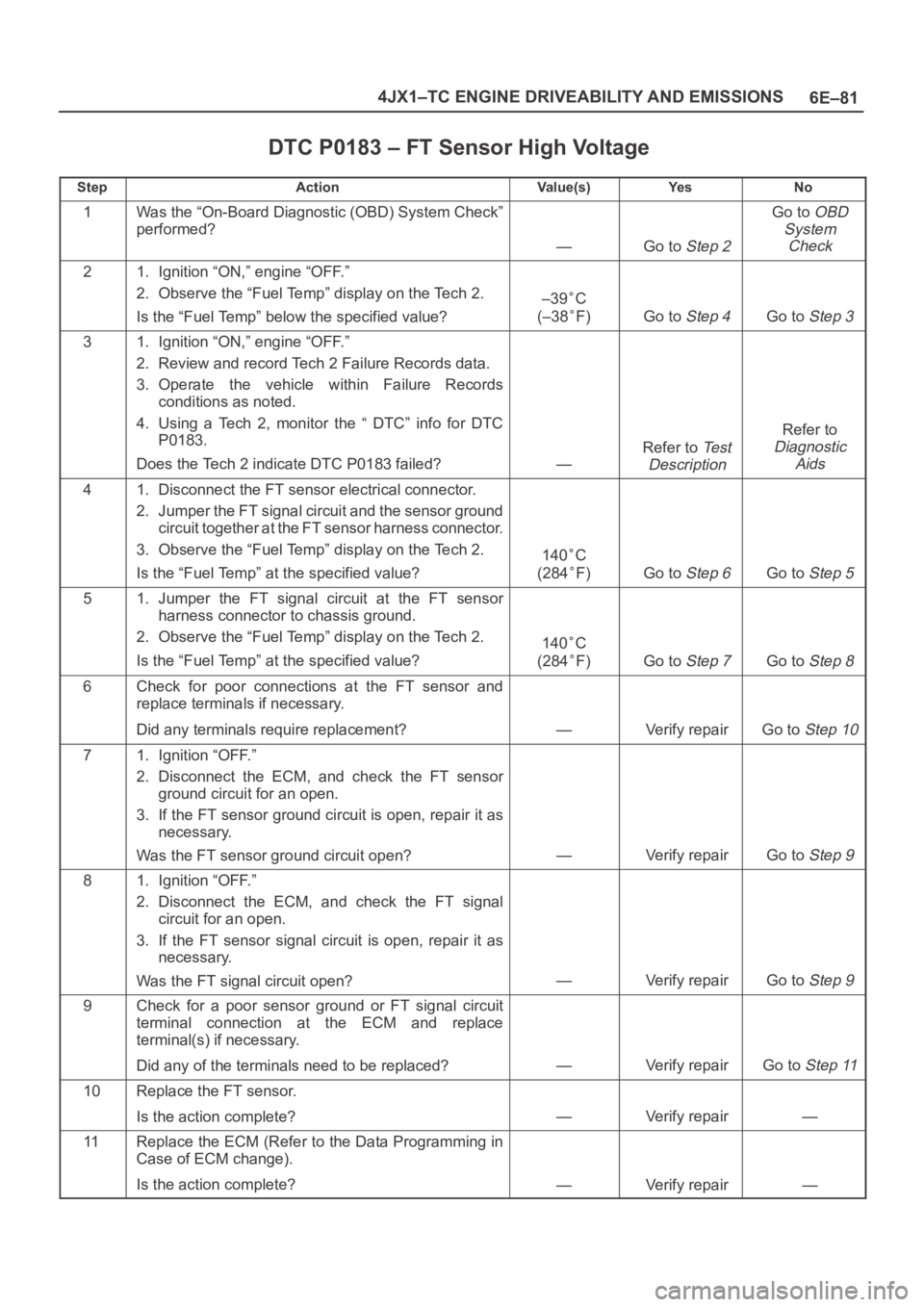
6E–81 4JX1–TC ENGINE DRIVEABILITY AND EMISSIONS
DTC P0183 – FT Sensor High Voltage
StepActionVa l u e ( s )Ye sNo
1Was the “On-Board Diagnostic (OBD) System Check”
performed?
—Go to Step 2
Go to OBD
System
Check
21. Ignition “ON,” engine “OFF.”
2. Observe the “Fuel Temp” display on the Tech 2.
Is the “Fuel Temp” below the specified value?
–39C
(–38
F)Go to Step 4Go to Step 3
31. Ignition “ON,” engine “OFF.”
2. Review and record Tech 2 Failure Records data.
3. Operate the vehicle within Failure Records
conditions as noted.
4. Using a Tech 2, monitor the “ DTC” info for DTC
P0183.
Does the Tech 2 indicate DTC P0183 failed?
—
Refer to Te s t
Description
Refer to
Diagnostic
Aids
41. Disconnect the FT sensor electrical connector.
2. Jumper the FT signal circuit and the sensor ground
circuit together at the FT sensor harness connector.
3. Observe the “Fuel Temp” display on the Tech 2.
Is the “Fuel Temp” at the specified value?
140C
(284
F)Go to Step 6Go to Step 5
51. Jumper the FT signal circuit at the FT sensor
harness connector to chassis ground.
2. Observe the “Fuel Temp” display on the Tech 2.
Is the “Fuel Temp” at the specified value?
140C
(284
F)Go to Step 7Go to Step 8
6Check for poor connections at the FT sensor and
replace terminals if necessary.
Did any terminals require replacement?
—Verify repairGo to Step 10
71. Ignition “OFF.”
2. Disconnect the ECM, and check the FT sensor
ground circuit for an open.
3. If the FT sensor ground circuit is open, repair it as
necessary.
Was the FT sensor ground circuit open?
—Verify repairGo to Step 9
81. Ignition “OFF.”
2. Disconnect the ECM, and check the FT signal
circuit for an open.
3. If the FT sensor signal circuit is open, repair it as
necessary.
Was the FT signal circuit open?
—Verify repairGo to Step 9
9Check for a poor sensor ground or FT signal circuit
terminal connection at the ECM and replace
terminal(s) if necessary.
Did any of the terminals need to be replaced?
—Verify repairGo to Step 11
10Replace the FT sensor.
Is the action complete?
—Verify repair—
11Replace the ECM (Refer to the Data Programming in
Case of ECM change).
Is the action complete?
—Verify repair—
Page 5512 of 6000
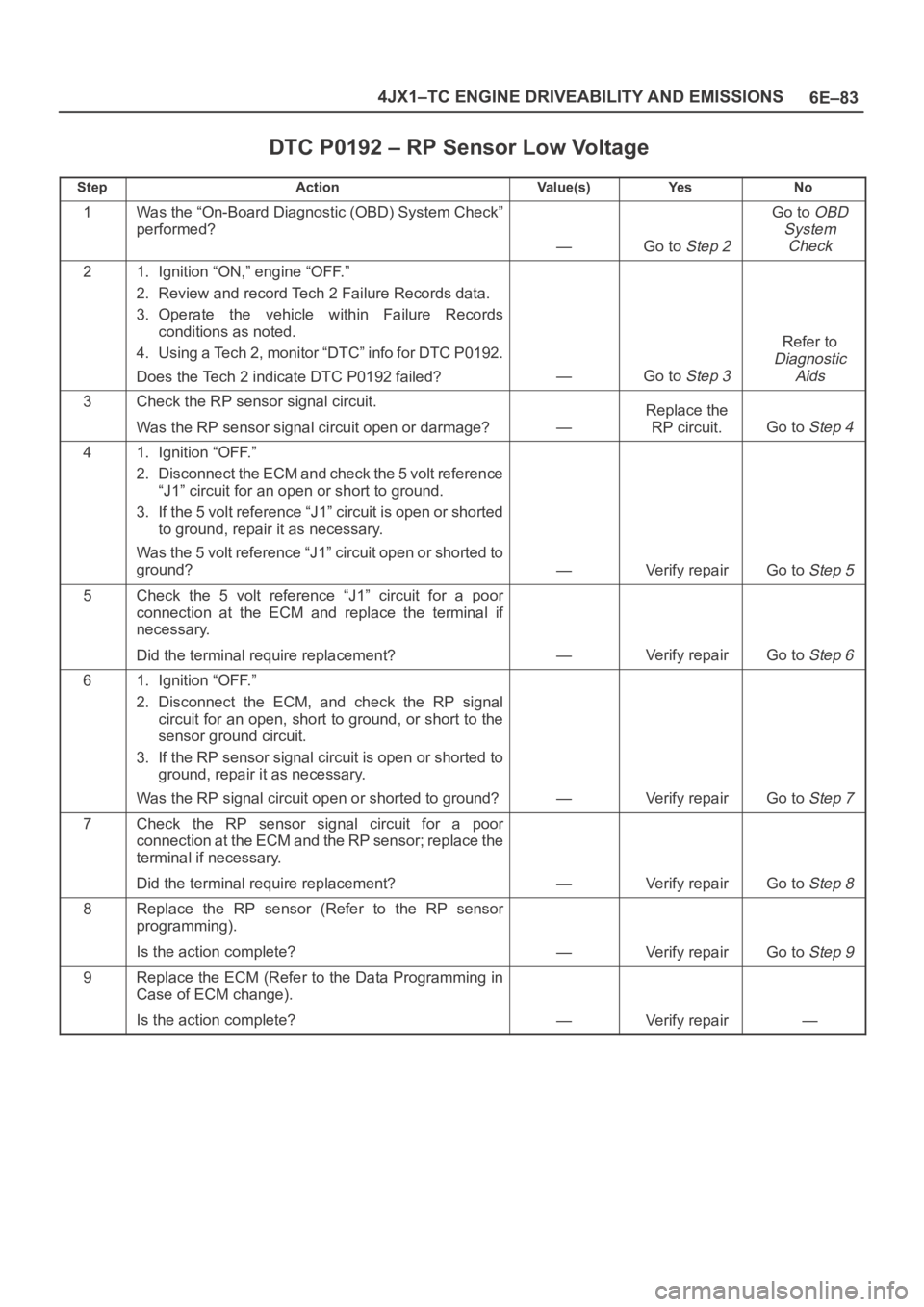
6E–83 4JX1–TC ENGINE DRIVEABILITY AND EMISSIONS
DTC P0192 – RP Sensor Low Voltage
StepActionVa l u e ( s )Ye sNo
1Was the “On-Board Diagnostic (OBD) System Check”
performed?
—Go to Step 2
Go to OBD
System
Check
21. Ignition “ON,” engine “OFF.”
2. Review and record Tech 2 Failure Records data.
3. Operate the vehicle within Failure Records
conditions as noted.
4. Using a Tech 2, monitor “DTC” info for DTC P0192.
Does the Tech 2 indicate DTC P0192 failed?
—Go to Step 3
Refer to
Diagnostic
Aids
3Check the RP sensor signal circuit.
Was the RP sensor signal circuit open or darmage?
—
Replace the
RP circuit.
Go to Step 4
41. Ignition “OFF.”
2. Disconnect the ECM and check the 5 volt reference
“J1” circuit for an open or short to ground.
3. If the 5 volt reference “J1” circuit is open or shorted
to ground, repair it as necessary.
Was the 5 volt reference “J1” circuit open or shorted to
ground?
—Verify repairGo to Step 5
5Check the 5 volt reference “J1” circuit for a poor
connection at the ECM and replace the terminal if
necessary.
Did the terminal require replacement?
—Verify repairGo to Step 6
61. Ignition “OFF.”
2. Disconnect the ECM, and check the RP signal
circuit for an open, short to ground, or short to the
sensor ground circuit.
3. If the RP sensor signal circuit is open or shorted to
ground, repair it as necessary.
Was the RP signal circuit open or shorted to ground?
—Verify repairGo to Step 7
7Check the RP sensor signal circuit for a poor
connection at the ECM and the RP sensor; replace the
terminal if necessary.
Did the terminal require replacement?
—Verify repairGo to Step 8
8Replace the RP sensor (Refer to the RP sensor
programming).
Is the action complete?
—Verify repairGo to Step 9
9Replace the ECM (Refer to the Data Programming in
Case of ECM change).
Is the action complete?
—Verify repair—
Page 5514 of 6000
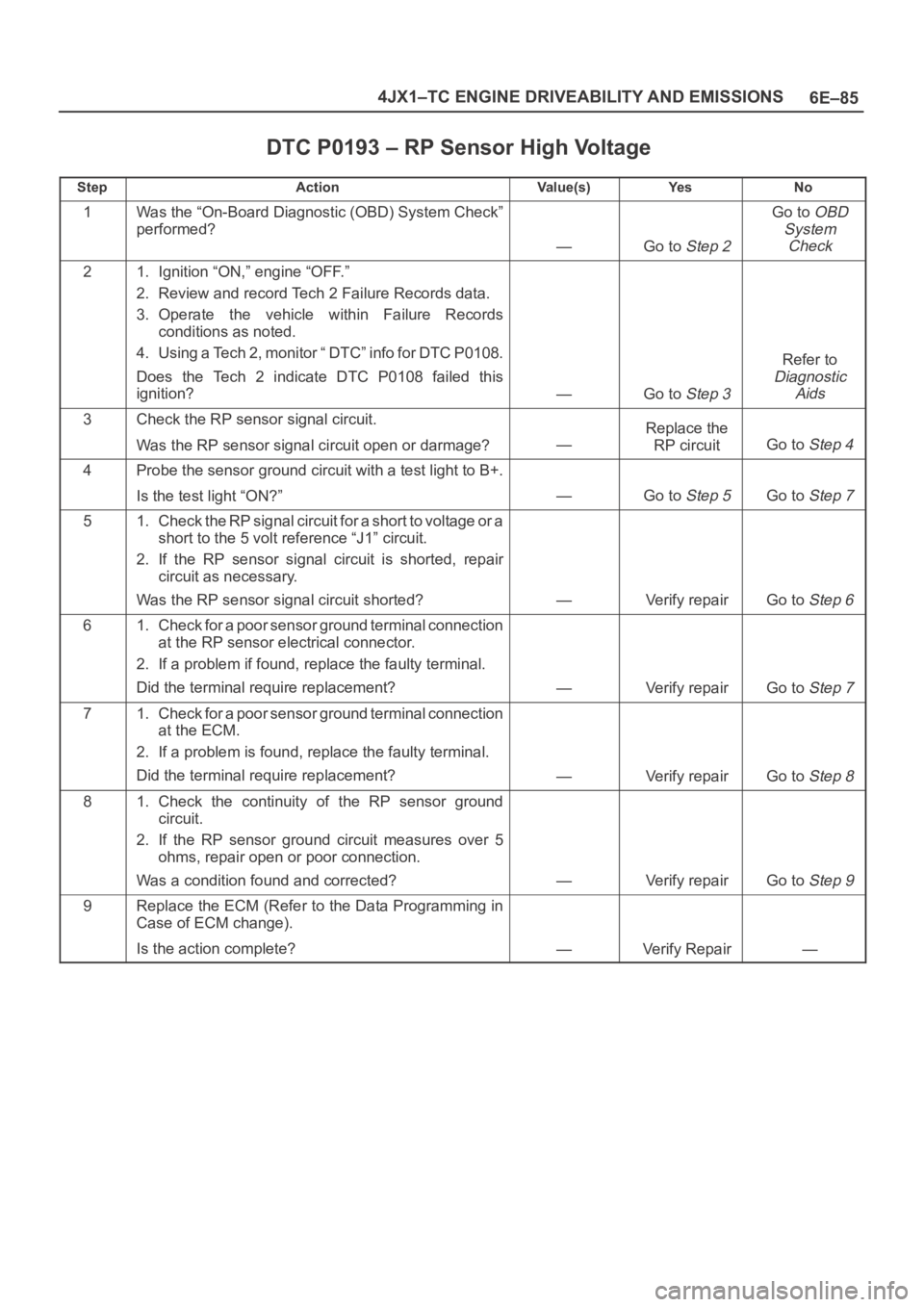
6E–85 4JX1–TC ENGINE DRIVEABILITY AND EMISSIONS
DTC P0193 – RP Sensor High Voltage
StepActionVa l u e ( s )Ye sNo
1Was the “On-Board Diagnostic (OBD) System Check”
performed?
—Go to Step 2
Go to OBD
System
Check
21. Ignition “ON,” engine “OFF.”
2. Review and record Tech 2 Failure Records data.
3. Operate the vehicle within Failure Records
conditions as noted.
4. Using a Tech 2, monitor “ DTC” info for DTC P0108.
Does the Tech 2 indicate DTC P0108 failed this
ignition?
—Go to Step 3
Refer to
Diagnostic
Aids
3Check the RP sensor signal circuit.
Was the RP sensor signal circuit open or darmage?
—
Replace the
RP circuit
Go to Step 4
4Probe the sensor ground circuit with a test light to B+.
Is the test light “ON?”
—Go to Step 5Go to Step 7
51. Check the RP signal circuit for a short to voltage or a
short to the 5 volt reference “J1” circuit.
2. If the RP sensor signal circuit is shorted, repair
circuit as necessary.
Was the RP sensor signal circuit shorted?
—Verify repairGo to Step 6
61. Check for a poor sensor ground terminal connection
at the RP sensor electrical connector.
2. If a problem if found, replace the faulty terminal.
Did the terminal require replacement?
—Verify repairGo to Step 7
71. Check for a poor sensor ground terminal connection
at the ECM.
2. If a problem is found, replace the faulty terminal.
Did the terminal require replacement?
—Verify repairGo to Step 8
81. Check the continuity of the RP sensor ground
circuit.
2. If the RP sensor ground circuit measures over 5
ohms, repair open or poor connection.
Was a condition found and corrected?
—Verify repairGo to Step 9
9Replace the ECM (Refer to the Data Programming in
Case of ECM change).
Is the action complete?
—Verify Repair—